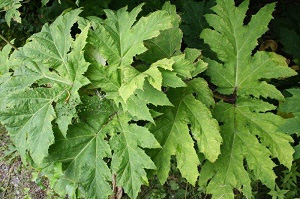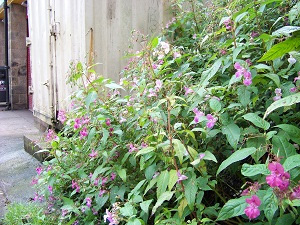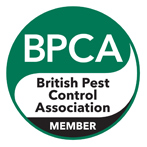PESTMAN Invasive Plant Species
01737 668603 or 07772541778
E mail lifetecltd@hotmail.co.uk
Our technicians are fully trained and qualified and hold PA1, PA6 and PA6W accreditation allowing us to treat and control invasive plants on land and in and around water. We are also licensed waste carriers.
We can offer a number of treatment options dependant on your individual needs. All of our treatments are carried out following the Environment Agency code of practice.

Japanese knotweed (Fallopia japonica)
Japanese knotweed has become increasingly well known in recent years, and is a growing commercial problem because of the challenges it causes in the urban environment. The plant, which is native to eastern Asia, was introduced in the early 19th century to adorn the gardens of Victorian England. As early as the beginning of the 20th century it was widely recognized as an invasive species. Where the plant grows on development sites it can cause damage to hard structures and surfaces. Developers also often need to tackle the plant in order to avoid contravening the Wildlife and Countryside Act 1981.
Japanese knotweed – Do’s
Contact Lifetec Ltd - the professionals.
Japanese knotweed - Dont's
Do not ignore Japanese knotweed when you see it in your garden or building plot. It can grow quickly and costs will grow as the plant does.
Don't cause the spread of Japanese knotweed stems and crowns. If you cut down Japanese knotweed, it is best to dispose of it on site.
Material taken off site is classified as waste and must be safely contained and disposed of at a licensed disposal site.
Don't try to dig up Japanese knotweed as this will lead to a significant increase in stem density. Even a tiny fragment of the cut rhizome is capable of regeneration.
Don't spread soil contaminated with Japanese knotweed rhizome. Any soil that is obtained from ground within 7 m horizontally and 3 m deep of a Japanese knotweed plant could contain rhizome. The rhizome is highly regenerative and will readily grow into new plants. Don't chip Japanese knotweed material. Mechanical chippers don't kill Japanese knotweed. If you spread the chipped material on soil, Japanese knotweed could regrow.
Don't dump garden waste contaminated with Japanese knotweed in the countryside - you will be breaking the law.
Don't add Japanese knotweed to compost. If you cause Japanese knotweed to spread you are guilty of an offence under the Wildlife and Countryside Act, 1981
 Go to Top
Go to Top
Giant hogweed (Heracleum mantegazzianum)
Giant Hogweed was brought in to the UK as an ornamental plant. It is native of South-Eastern Europe and is a member of the carrot family. Generally it grows near watercourses and in damp meadows, though it can be found on waste ground where conditions are right. It is a highly invasive plant that grows vigorously. Each plant can produce up to 50,000 seeds which can survive for up to 15 years. Giant Hogweed is capable of growing to a height of up to 5 metres.
Contact with this invasive weed produces a skin reaction which is antagonised by exposure to sunlight. Blisters occur 24 to 48 hours after exposure. Damaged skin heals very slowly, leaving residual pigmentation that can develop into recurrent dermatitis.
A structured treatment program using appropriate herbicides allows giant hog wood to be effectively controlled.
 Go to Top
Go to Top
Himalayan balsam (Impatiens glandulifera)
Introduced to the UK in 1839 from Northern India, Himalayan or Indian balsam is most commonly found on river banks and damp areas, though it is capable of thriving in many other habitats.
The dense stands on river banks impede the flow in flood conditions exacerbating flooding. They also shade out native plant species.
Himalayan balsam also causes a less obvious problem for native species. Like many flowering plants, Himalayan balsam produces a sugary nectar to attract insects. However the flowers produce more nectar than any other native European species making it more attractive to bees and other insects, luring them away from pollinating our native flowers.
A structured treatment program using both herbicides and cultural control methods such as hand pulling can provide effective Himalayan balsam control. Annual treatments are needed, focussing on early control to kill plants before they seed.
 Go to Top
Go to Top

